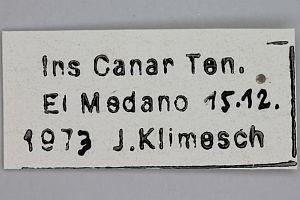Inhalt
2. Diagnose
2.1. Geschlecht nicht bestimmt
1-2: Spanien, Kanarische Inseln, Daten siehe Etikett (fot.: Michel Kettner), coll. ZSM, "Klimesch-Sammlung"
2.2. Erstbeschreibung
1-3: Walsingham (1908: 946-947 + pl. LI fig. 18) [nach Copyright-freien Scans auf www.biodiversitylibrary.org]
4. Weitere Informationen
4.1. Andere Kombinationen
- Amblona brachyptera Walsingham, 1908 [Originalkombination und bis Falck & Karsholt (2023) übliche Kombination]
4.2. Taxonomie
Nach Falck & Karsholt (2023) gehören alle Symmocinae der Kanarischen Inseln und Madeiras zu einer einzigen Gattung: Chersogenes. Sie erklären ferner die zwischenzeitlich als Synonym zu C. canariensis gestellte Epanastasis extricata wieder zur bona species.
4.3. Faunistik
Die Art wurde von Güímar auf Teneriffa beschrieben. Offensichtlich handelt es sich um einen Endemiten der Kanarischen Inseln. Falck & Karsholt (2023: 288) schreiben zur Verbreitung: "Known only from the southern coastal areas of the island of Tenerife, Spain."
(Autor: Erwin Rennwald)
4.4. Literatur
- Falck, P. & O. Karsholt (2023): The Symmocinae and Holcopogoninae in the Canary Islands and Madeira, with descriptions of 13 new species (Lepidoptera: Autostichidae). — SHILAP Revista de lepidopterología, 51 (202): 269-314. https://doi.org/10.57065/shilap.462. [zum PDF-Download auf shilap.org]
- Erstbeschreibung: Walsingham (1908): Microlepidoptera of Tenerife. — The Proceedings of the Zoological Society of London for the Year 1907: 911-1034 + pl. LI-LIII.




![Vorkommen auf den Kanarischen Inseln [Vives Moreno, A. (2014); Falck & amp; Karsholt (2023)]](/res/img/flag/es-cn.png)






